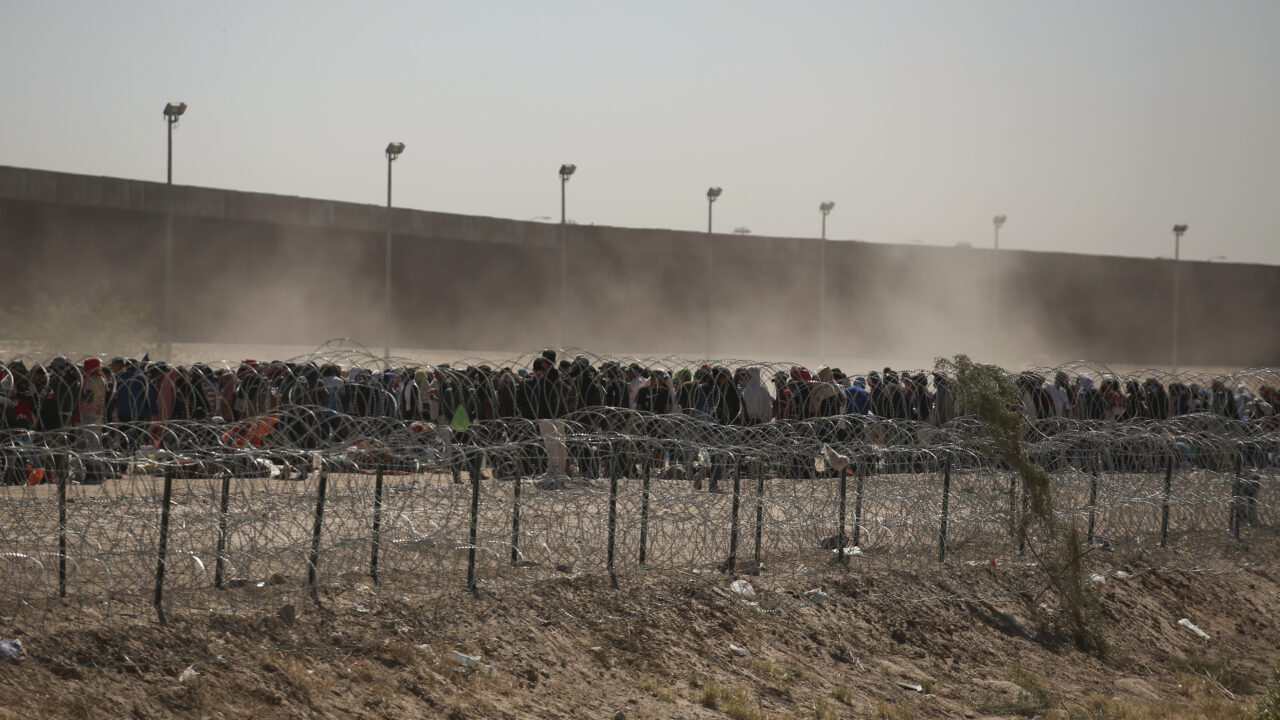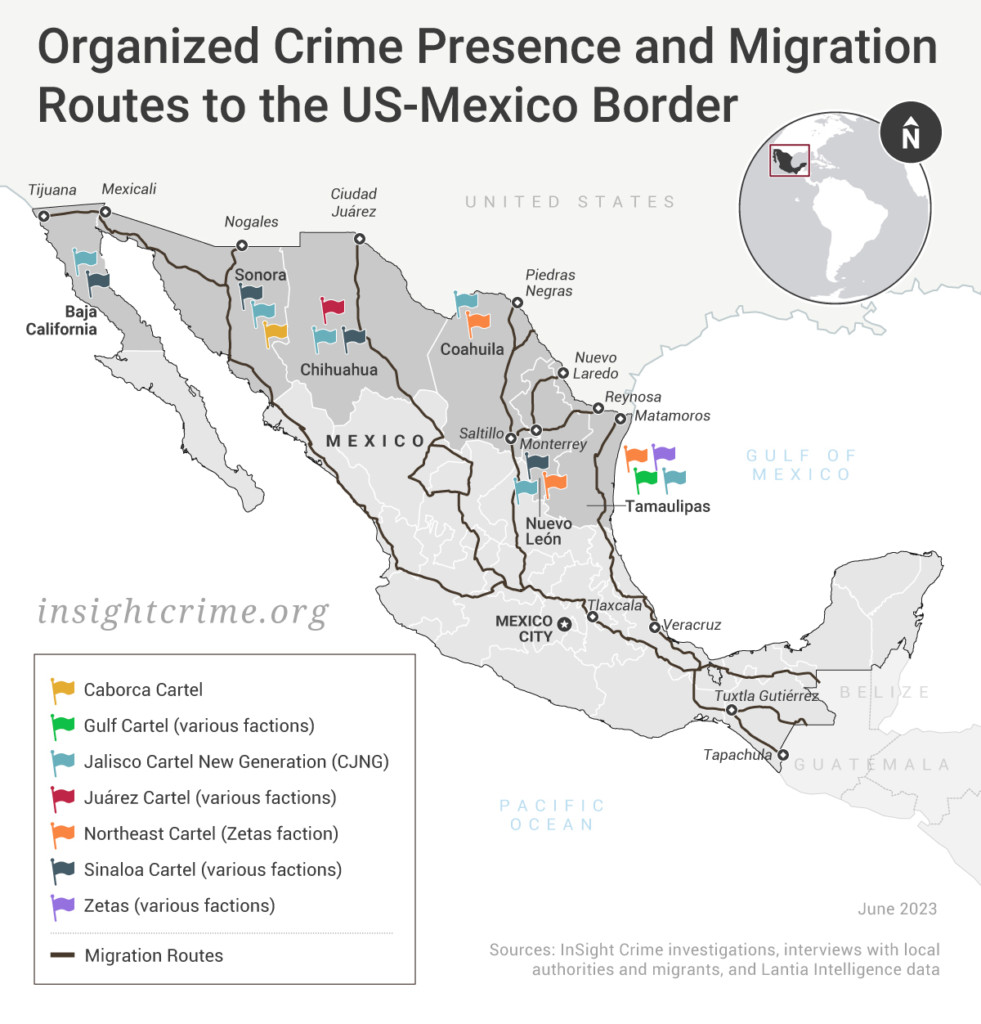How US Policy Exacerbates Migrant Kidnappings on the Mexico Border
The "prevention through deterrence" program has turned migration into a multi-layered criminal industry. Migrants line-up between a barbed-wire barrier and the border fence at the US-Mexico border, as seen from Ciudad Juarez, Mexico, May 9, 2023. AP Photo: Christian Chavez.
Migrants line-up between a barbed-wire barrier and the border fence at the US-Mexico border, as seen from Ciudad Juarez, Mexico, May 9, 2023. AP Photo: Christian Chavez.
It was just after dawn when Ricardo Montes* saw nearly a dozen armed men in two pickup trucks arrive at the central market in Reynosa. He had reached this city on the US-Mexico border just 20 minutes earlier, crammed into the back of a tractor trailer with around 200 other migrants.
At the market, taxi drivers and coyotes—the nominal guides who manage this cross-border flow of migrants — interrogated the new arrivals. What were their names? Where were they from? Did they have the clave, or keyword, that confirms they’ve obtained permission to cross the border in this area?
Terrified, the migrants fled, scattering in different directions. Montes, however, froze—17 days and nights of arduous, backbreaking travel from his native Guatemala had paralyzed him.
“So many days had passed, we had been through so much,” he told InSight Crime. “I was very tired, and I couldn’t run anymore. I couldn’t move anymore. I couldn’t do anything anymore.”
Montes was one of many. The armed men kidnapped him and between six and eight others that day. They drove them to a safe house less than a half hour away. It had a garden and nice windows, Montes said. But inside, concrete walls blocked the windows and a steel bar on the back door barricaded the migrants into a small living room.
“We’re from the Gulf Cartel,” Montes remembered the men saying.
The Gulf Cartel is one of Mexico’s oldest organized crime networks and has several different factions operating in Reynosa. Their demands were simple: they wanted money. They ordered Montes and each of the 30 migrants he estimated were at the safe house to pay $5,000.
US policies have exposed migrants to a greater risk of being killed, disappeared, extorted, and kidnapped.
With stone-cold bluntness, the men explained what would happen if the payment did not come quickly.
“We’ll kill you,” Montes remembered them saying.
Montes’ problem has become increasingly commonplace since the mid-1990s, when the US government began its so-called “prevention through deterrence” immigration policy. The idea was to quell the many migrants and asylum seekers attempting to enter the country by scaring them with more perilous pathways to the United States.
It is not clear how many migrants have decided the reward was not worth the risk, but the policy has had other, perhaps unintended consequences. First, the strategy pushed migrants to travel through barren deserts, high mountains, and waterless valleys that have caused an increase in the number of migrants who die and disappear en route.
Second, the strategy has changed the migration industry. It turned a once difficult but relatively manageable mom-and-pop operation that had deep connections to the populations they were servicing into a multi-layered criminal industry. This includes high-level criminal groups that are often seeking to extract every penny possible from the migrants and, in some cases, victimize them in the worst of ways.

US policies have also exposed them to a greater risk of being killed, disappeared, extorted, and kidnapped in isolated stretches of the border where criminal groups maintain a strong presence. The end result is that more migrants are dying on the US-Mexico border than ever before.
The dangers for asylum seekers like Montes became particularly acute following the enactment of policies like Migrant Protection Protocols (MPP) and Title 42. Also known as “Remain in Mexico,” MPP required migrants who requested asylum at or between ports of entry to wait for their immigration court hearings in Mexico.
Title 42 was a public health measure established amid the global COVID-19 pandemic that effectively suspended asylum and gave US officials the authority to expel those wishing to seek asylum back to Mexico or their home countries.
Both measures forced an increasing number of migrants to remain in Mexico or traverse the most dangerous passages of the journey multiple times. For the criminal groups seeking to take advantage of them, it was simple math.
“This creates a market for people to be able to find ways to cross our border outside of the ports of entry, and that market is being filled by organized crime,” said one US attorney who works closely with asylum seekers.
These policies have ended, but the US government introduced new restrictions that effectively keep migrants in Mexico. Meanwhile, organized crime groups have diversified their criminal portfolios and became more involved in the business of migrant smuggling.
In our year-long research into this phenomenon, which we published in a report documenting the impact of US migration policy on organized crime, this manifested itself in a number of ways.
In some parts of the border, criminal groups oversaw makeshift shelters and collected a tax of at least $100 per migrant crossing through corridors they control. In others, they employed their own coyotes to smuggle migrants and even hired lookouts to scout shelters for prospective clients.
However, some became more nefarious and created specialized divisions dedicated to kidnapping migrants for ransom. This was what Montes ran into in Reynosa. There, the Gulf Cartel had begun taking migrants captive in massive numbers. The phenomenon was not new but expanded with the increasing number of potential victims, lawyers, activists, and migrants told InSight Crime during our research.
It’s “created a situation [where you have] thousands of sitting ducks,” the lawyer added.
The next morning, the group blindfolded him, placed him into the back of a truck, drove him about 30 minutes away from the safe house, and left him on the side of a highway.
By the time he reached Reynosa, Montes had paid his smuggling network two-thirds of the nearly $10,000 he owed for the journey. But he did not have another $5,000 to pay his kidnappers.
The potential consequences of that fact became immediately apparent when his captors began beating some of the migrants in front of him. In a panic, Montes frantically negotiated.
“Give me a few weeks,” he pleaded. “And I will get you the money.”
Thankfully, they agreed. Montes’ partner began to reach out to all their relatives and friends in the United States and Guatemala and gather the money in dribs and drabs. After a few days, they made the first payment. Twenty days later, his partner in Guatemala transferred the final payment.
The next morning, the group blindfolded him, placed him into the back of a truck, drove him about 30 minutes away from the safe house, and left him on the side of a highway. Montes walked to the nearest gas station and called his partner in Guatemala. His partner then contacted the smuggling network so they could come pick him up and finish the final leg of his trip to the United States.
His smugglers were furious. He said that, before reminding him of the $3,000 he still owed once he reached his destination, they scolded him for not being more careful.
“It’s your fault,” Montes remembered them yelling through the phone. “You allowed them to kidnap you.”
*For security reasons, InSight Crime has changed the protagonist’s name.
Your support matters…Independent journalism is under threat and overshadowed by heavily funded mainstream media.
You can help level the playing field. Become a member.
Your tax-deductible contribution keeps us digging beneath the headlines to give you thought-provoking, investigative reporting and analysis that unearths what's really happening- without compromise.
Give today to support our courageous, independent journalists.

You need to be a supporter to comment.
There are currently no responses to this article.
Be the first to respond.